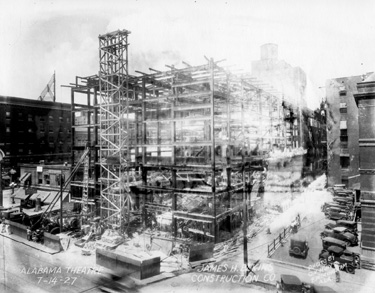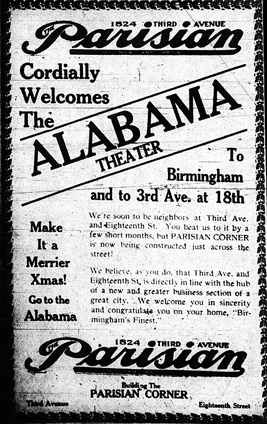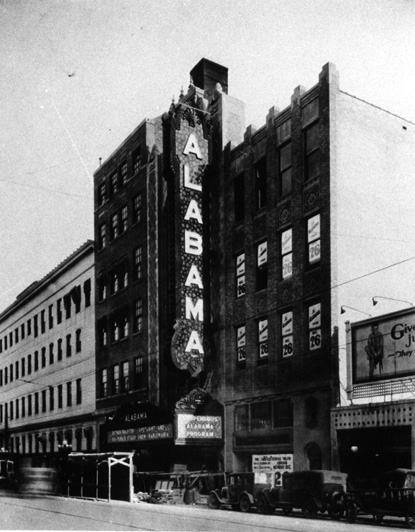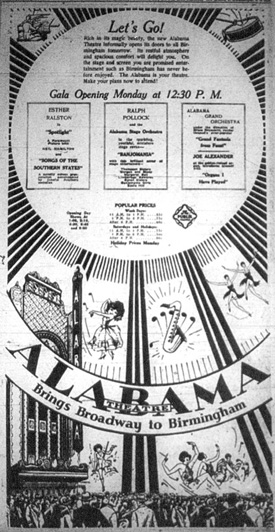| The
young man craned his neck in the cold December air, trying to take in the
sign flashing above him. He stepped back, watching as the seven letters
"A-L-A-B-A-M-A" glowed in the night sky, the word they formed surrounded
by a sea of other lights, all twinkling in a fiery circle.
"Alabama," the boy said under his breath, watching as the word came out in a vapor on the chilly air. "I've never seen anything like it." - Tommy Black,
The
Birmingham News, 10/11/1980
|
|
The above scene, described so eloquently by News writer Black, was admittedly imaginary, but it is well within the realm of possibility that it could have happened. When Birmingham residents saw the opulence of the Alabama Theatre for the first time in the last week of 1927, all of a sudden the other theaters that lined Second and Third Avenues were made to look like a nickel -- or a nickelodeon, as the case may be. The reason the Alabama outshown its brethren can be directly attributed to the status of its original owner. That company had been founded by producers Adolph Zukor and Jesse Lasky, with the resulting entity known technically as Famous Players-Lasky. Since such a name would have looked rather odd on the screen, it usually chose to be known as Paramount, which was actually the name of its subsidiary distribution arm. In those early days of the movies, studios were able to grow as powerful as they did because they not only produced the films, but they also owned the theaters where those pictures were shown. Paramount was no different, and by the 1920s had its own division known as Publix Theaters. The Paramount-Publix theaters were among the most elaborate movie palaces ever built during the latter half of the 1920s; the company's flagship was the gigantic Paramount Theater in New York City, opened in 1926.
The News announced that construction on this new edifice would begin in October, and was expected to be complete within a year of that date. It took a little longer than that, but the wait was certainly worth it. As with any large undertaking, there were obstacles to be overcome. Paramount-Publix originally wanted its new movie palace to occupy the entire space between the Loveman, Joseph & Loeb department store building and Eighteenth Street, but the occupants of the building on the corner had a long term lease and were not willing to surrender it unless they were paid a large bonus. For this reason, the Alabama was built in the shape of an L, with the entrance on Third Avenue and patrons then having to make a sharp right turn into the main auditorium, which backed up into Eighteenth Street. (Many decades later, the Alabama had the last laugh on its obstinate corner occupants, as we shall see.) |
 |
|
 Another
change from the original plans had to do with the height of the structure.
Paramount-Publix intended for the Alabama Theatre building to be seven
stories tall, with neighbor Loveman's sharing space on the upper floors.
This proved to be unworkable, and a good thing, too, since within a few
years the Loveman building would burn to the ground and it would have spelled
disaster for the Alabama if the two had been joined at the shoulder. Another
change from the original plans had to do with the height of the structure.
Paramount-Publix intended for the Alabama Theatre building to be seven
stories tall, with neighbor Loveman's sharing space on the upper floors.
This proved to be unworkable, and a good thing, too, since within a few
years the Loveman building would burn to the ground and it would have spelled
disaster for the Alabama if the two had been joined at the shoulder.
Work on the building began later than anticipated, in March 1927, and
it progressed steadily. By September 28, the newspaper was announcing that
the Alabama would be ready to open by December 15. They didn't quite make
that date, either. The estimated cost had ballooned from the original million
to $1,250,000, and the newspaper further reported:
Buried down in the description of all the theater's amenities, including a pianist on the mezzanine who would play requests from the customers, was a reference that today seems pitifully small considering the role it was to play in securing the building's future: The organ will be one of the finest in the South and a famous organist will be here to demonstrate it on opening week. It was built according to the specifications of Jesse Crawford, organist known to all purchasers of phonograph records."
At last the big day came. In fact, two big days came! Sunday, December 25, 1927, was Christmas Day, and the following afternoon the Alabama Theatre had its formal grand opening. The timing of these two events was a boon for the newspaper writers, who trumpeted the event as "Birmingham Gets $1,500,000 Christmas Gift in Alabama Theatre." (Apparently the cost had made another jump.) A style of newspaper writing seldom seen any more is demonstrated in the opening paragraphs by Birmingham News writer Dolly Dalrymple, who positively gushed: "When 'Miss Birmingham' awoke this Christmas morn in the year of 1927, and gazed into her silk stocking hung gracefully by the municipal fireside, her eyes opened wide in amazement, her heart expanded largely, and her joy knew no bounds for, ensconced in that delectable hiding place was a gift which few cities can boast of and of which this city is eminently proud. |
 |
 |
| "Namely -- a magnificent $1,500,000 theater,
the gift of that splendid organization known as the Publix Theaters Corporation,
which, realizing Birmingham's colorful past, her magnificent present and
her roseate future ever progressing, ever growing, has put 'the big pot
in the little one' and spread itself all over the face of the earth in
giving to the Magic City the newest, the most modern, the most artistic
and the most comfortable theater that money and talent can devise."
While Ms. Dalrymple takes an aspirin and rests on the couch to recover from her initial euphoria, let's throw open the doors of the Alabama for ourselves and see what all the breathlessness was about. Without a doubt, it was unlike anything Birminghamians had ever seen. Making an entrance into the lobby, they were first confronted by the two-story Hall of Mirrors (instead of three stories as originally planned). Moving into the main lobby, visitors were surrounded by antique furniture and art objects said to have been purchased by Paramount from a castle in Spain, and subsequently divided between Publix theaters in Los Angeles, New York, and their new Southern buddy Birmingham. To reach the mezzanine or balcony required a strenuous climb up some imposing staircases, but those with lazier constitutions could enter the main auditorium on the ground floor, passing through wrought iron gates constructed entirely of the letter A (for Alabama, of course) in a variety of configurations. |
| That main auditorium was enough to make even the most jaded Birmingham
moviegoer gasp. Five stories tall at its highest point, there was seating
for 2,500 patrons at one time, and the last row of the top balcony was
180 feet from the movie screen. The stage was equipped with an orchestra
pit, and another pit that contained (when not in use) the Mighty Wurlitzer
pipe organ. Modern-day movie buffs may have a tendency to forget that,
for all its splendor, the Alabama Theatre was built to show silent movies.
It was traditional in those days for the theater orchestra to provide the
accompaniment for movies during nighttime performances, while for matinees
the organ alone had to take the place of the higher-priced orchestra. At
first glance, it would appear that there were box seats available near
the stage on either side of the proscenium arch, but these were nothing
but cleverly-designed disguises for the chambers that held the massive
ranks of pipes that gave the Wurlitzer the "mighty" part of its name.
Outside the auditorium, customers would find a multitude of other comforts that would far outshine anything they might have at home. There were men's and women's lounges, each of which was decorated in a scheme to make it totally unique from the others: the "ladies lounge" on the balcony resembled a Chinese tea room, while the one on the main floor went after a Spanish feel. The men's lounges were decorated as a circa 1388 A.D. Tudor manor hall (balcony) and an old English hunting lodge (on the ground floor). The theater was air conditioned, but not in the form as we know the term today. The 1927 definition of air conditioning involved an elaborate system of circulating the stale air from the auditorium into a series of ducts that opened to the outside, while fresh air was pumped in from the ceiling. When cool air was needed during the summer months, the circulating air was blown over ice manufactured by a huge apparatus in the basement.
From the time of its opening, the Alabama became the premier theater of Birmingham, as it was intended to be. It is said that Paramount Pictures chief Adolph Zukor himself gave the edifice its nickname when he visited in person: "The Alabama Theatre is the Showplace of the South," he is reported to have commented, and that slogan stuck with the building forever after. By the early 1930s, the theater had gotten over some of its newness and was beginning to settle into its own routine. In 1931, Stanleigh Malotte arrived at the Alabama to begin serving as organist, a position he would hold until the late 1950s. Unfortunately, of that more than twenty-five year career, only one recording of Malotte's organ technique is known to have survived. During the 1940s Malotte divided his time between the theater and radio station WAPI, and a short Malotte radio program that happened to be preserved on a transcription disc is the only concrete evidence of his voice and playing style. In this 1944 recording he demonstrates some of the comedy and humorous musical sound effects for which he was famous, and ends with a brief rendition of his theme song, "Stars Fell on Alabama," an oblique reference to his theater work. In later years, Malotte described his formula for entertaining audiences as, "I play loud, I move around a lot, I use a lot of bells, and end with a patriotic song. You just can't go wrong doing that."
Around the time Malotte arrived at the Alabama, the playhouse became
the weekly Saturday meeting spot for local boys and girls who were members
of the Mickey Mouse Club. This was a promotion dreamed up
by that impossible dreamer Walt Disney himself and instituted in
movie theaters across the nation. From Orlando to Anaheim, kids gathered
at their local showplaces to watch Disney cartoons (naturally), play games,
and see amateur talent shows, all the while squeaking the Club slogan:
Things were no different in Birmingham, although the Alabama did claim
at one time the distinction of having the largest Mickey Mouse Club in
the world, numbering some 10,000 junior Mickeys. The ringleader of the
rat pack during the 1930s was the theater's assistant manager, George
Neleans, who was known to the kids as "Grandpa Mickey Mouse." The
Birmingham News reported on how "Grandpa" managed to keep any sort
of discipline among the 2,000+ youngsters who crowded into the theater
every Saturday:
|
| For a while, the weekly shenanigans were broadcast
over WBRC Radio. Local stores such as Pizitz, Sears,
and Loveman's
provided prizes to be given away, for which they received
the thanks of being known as "Big Brother Mickey Mice." In
March 1934, however, the weekly Mickey Mouse Club meeting was interrupted
by a gift from Loveman's that the department store would have preferred
not to give. During the afternoon performance, a fire quickly engulfed
the entire 1899 building.
Parents who had left their children in the care of Mickey and his cartoon and human friends were understandably hysterical, but fortunately a 36-inch firewall separated the department store from the Alabama, so while Loveman's burned to the ground the theater remained intact with only a bit of smoke damage. When the new Loveman's building was constructed on the spot where the old one had stood, a passageway was made from the top floor of the Alabama into the employees' lounge of the store, and the two establishments would share their joys and sorrows forever after.
Despite revolving ownerships, the Alabama Theatre remained virtually unchanged from its opening right up until the early 1960s. The most significant alteration made during that long span of time was the installation of a modernized air conditioning system in 1952. The exterior of the theater was noticeably changed in May 1960 when current manager Cecil McGlohon oversaw the erection of a new marquee that completely replaced the original 1927 masterpiece. Whereas the "old" marquee contained hundreds of screw-in light bulbs and featured the "ALABAMA" logo prominently (at one time it also had a panel boasting "A PUBLIX THEATER"), the new marquee was lighted from within by neon tubing, with horizontal bands of "chasing" bulbs above and below. Thankfully, they were wise enough to leave the giant vertical sign alone during all this modernization.
By 1972, trouble was just beginning to show its ugly face around the Alabama. In a valiant effort to keep the old-fashioned theater from looking too outdated, a complete facelifting was completed in February of that year. New red carpet, drapes, and curtains (including a new stage curtain) were installed, and the main floor of the auditorium was fitted with new, roomier seats and wider aisles. Unfortunately, this also reduced the seating capacity of the main floor from 1,200 to 923. The balcony retained its original 1927 carpet, and in fact was frequently closed to the public when the demand for the extra seating was not so great. It has been generally agreed upon that the last big event to take place at the Alabama was the 1973 Birmingham premiere of The Godfather. After all of that hoopla, things began a rapid downward spiral. By 1978, current ABC Theaters manager Cecil Brown was having to squash persistent rumors that the Alabama was in serious trouble. The downtown institution was subsisting on programs for school children and ladies' shopping matinees, while its nighttime business dropped off as the neighborhood around the theater slowly decayed. In fact, by that time the Alabama was the only operating downtown theater that had not been reduced to showing greasy exploitation features. (As we shall see, the Ritz was closed, the Lyric was being used as the "Foxy Adult Cinema," and the Empire and Melba were wallowing in sleaze of the not-quite-X-rated variety.) The Birmingham News could see that the vultures were beginning to circle over the Alabama's marquee; in a sinister tone, the newspaper said: "For some, the queen may look more attractive dead than alive. The building sits on very valuable land. And the materials used in construction -- such as the gold leaf -- could bring a small fortune on the market." Such thoughts were enough to send a shiver down the Alabama's huge vertical sign. To ward off possible future trouble, during 1978 the theater was placed on the National Register of Historic Places. However, as the News leered, "That won't guarantee its existence, but it will require that some consideration be given to any such drastic action as tearing the building down." Things didn't get any better. Later that year, ABC Theaters sold their giant-sized millstone to the Plitt Theater chain, which decided to spend the autumn of 1980 by showing classic movies at the Alabama instead of trying to attract current hits. The rest of Third Avenue continued its steady decline, with the April 1980 closing of Loveman's making the Alabama seem like the old kid on the block. During this bleak period in the theater's history, the Mighty Wurlitzer was practically ignored by the public, but not by members of the Alabama chapter of the American Theater Organ Society (ATOS), who worked tirelessly to be sure the magnificent instrument was kept in some sort of working order. What was going to become of the physical structure that housed the organ was not their primary concern -- at least not at that particular time.
During the Costa-Head days, the ATOS Alabama Chapter would occasionally lease the theater for organ recitals and other such activities. Leading the charge in the drive to keep the theater afloat was Cecil Whitmire, who had arrived in Birmingham after a long run as organist at the Tennessee Theatre in Knoxville, and who had become the Alabama's organist in 1977 for lack of anyone else who wanted the position. From May to October 1986 the group embarked on its most ambitious fundraising campaign yet: as the previous owners had done, a series of classic movies was scheduled to be shown at the Alabama. This was enough of a success that 15 more cinema classics were scheduled for October 1986 through April 1987. Changing times weren't finished with the Alabama yet, though. The winter/spring film series was a decided disaster, attendance-wise, with some of the films attracting less than 70 people per showing. Whitmire and his hardy crew of volunteers knew that rough times were ahead: "We can't sell nostalgia forever," he reasoned. "We have to generate a new audience for the theater." Making matters worse was the fact that the Costa-Head partnership -- the Alabama's official legal owner -- had filed for bankruptcy in June 1986. This meant that to keep the theater open at all, ATOS had to foot the $10,000-per-month bill of maintaining the building. Desperate times call for desperate measures, and in March 1987 ATOS announced that it intended to buy the Alabama from the failed Costa-Head partnership for one million dollars. This began a complicated series of maneuvers that ended up with ATOS making a $100,000 down payment on the building. Realizing that unless they were able to gain complete control of the theater its future would be in doubt, Whitmire used the news media to take his group's case to the public. There had long been a sore spot in Birmingham over the 1969 demolition of the magnificent railroad terminal on Fifth Avenue, and ATOS used that infamous event as a reference point. Whitmire took that scar in historical preservation and made it into a festering boil, emphasizing that the same thing would happen to the Alabama Theatre if the necessary funds were not raised. It pushed all the right buttons for the public, and ATOS collected more than the amount needed for the down payment. By allowing Costa and Head to retain parts of the building as office space, the total cost was reduced from one million dollars to $777,000.
The mortgage on the building hung over Birmingham Landmarks' head like the ornate domed ceiling in the Alabama's auditorium, but donations and pledges were coming in on a regular basis. Even Stan Malotte, who had passed away in 1972 after having spent most of his post-Alabama years at the Fox Theatre in Atlanta, was able to help his alma mater. Theater organist and historian John W. Langdon of Kentucky had somehow come into possession of the 1944 recording of Malotte's radio broadcast, and he in turn donated it to an Alabama-based radio organization, the National Lum and Abner Society. This group made the Malotte performance available to the Alabama Theatre, which sold cassettes of the broadcast for $25 each as part of its fundraiser. One of these tapes found its way to Malotte's son, Stan Jr. He traveled from his home in California to Birmingham to make a rare appearance at the unveiling of a star in his father's honor on the sidewalk in front of the theater. It was in 1992 that the Alabama finally managed to buy the building on the corner of Third Avenue and Eighteenth Street that had been the holdout when the property was originally purchased in 1926. By then known as the Goldstein Furs Building, the mostly-vacant structure was acquired by Birmingham Landmarks for $185,000. At the same time, the Alabama began taking more steps to become a true performing arts center rather than simply a museum of the past. A bar was installed on the mezzanine level, to be used during suitable events. By now, the classic films that had brought attention back to the theater were relegated to summer showings, as that was traditionally the slowest time of year for live stage shows. Under the direction of Whitmire and Birmingham Landmarks, the Alabama underwent a complete renovation, and there never seemed to be an end to the plans for the future. One of the theater's goals has been to install an elevator that would provide an alternative to the stairways leading to the balcony; another has been to increase the number of restrooms available for public use. There has even been talk of replacing the 1960 marquee with an electronic message board, which would nonetheless be designed to more closely resemble the long-gone 1927 Publix marquee. It just may be that out of all the retail establishments and theaters that operated in downtown Birmingham over the years, the Alabama Theatre may be the only one that has managed to survive in anything resembling its original form and function. If a single business had to do it, the Alabama would probably be the best choice for the job! |
| We at BIRMINGHAM REWOUND highly recommend Cecil Whitmire's lavish coffee table book detailing the Alabama's history, available through the theater's web site, www.alabamatheatre.com. Check it out! |
|
Page created 06/25/2006 -- 348 PM EDT |